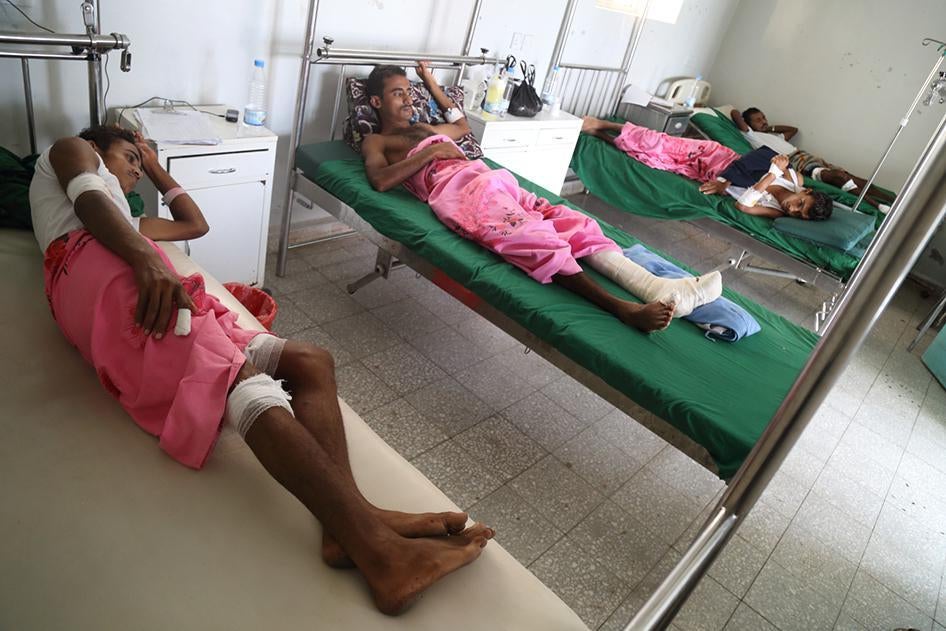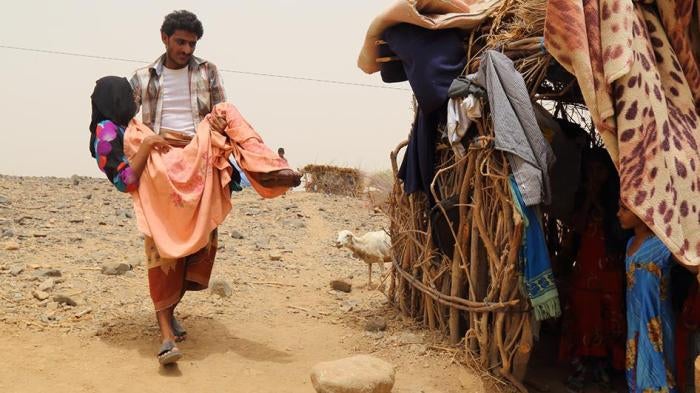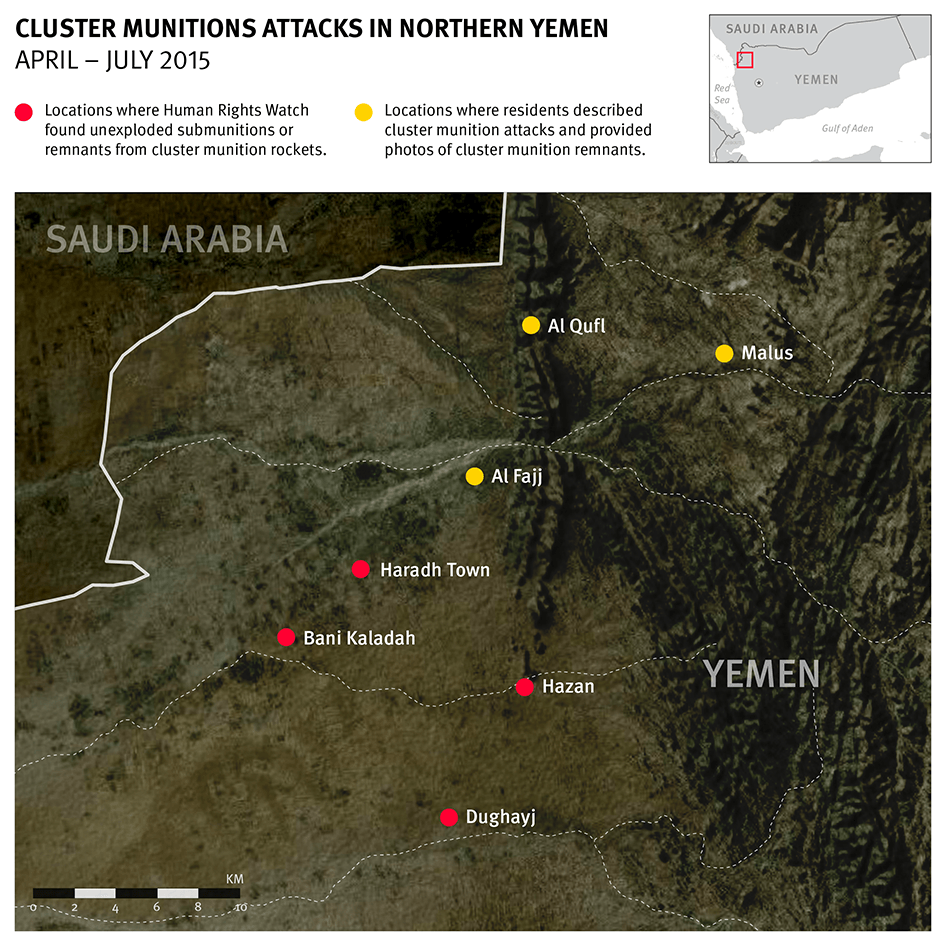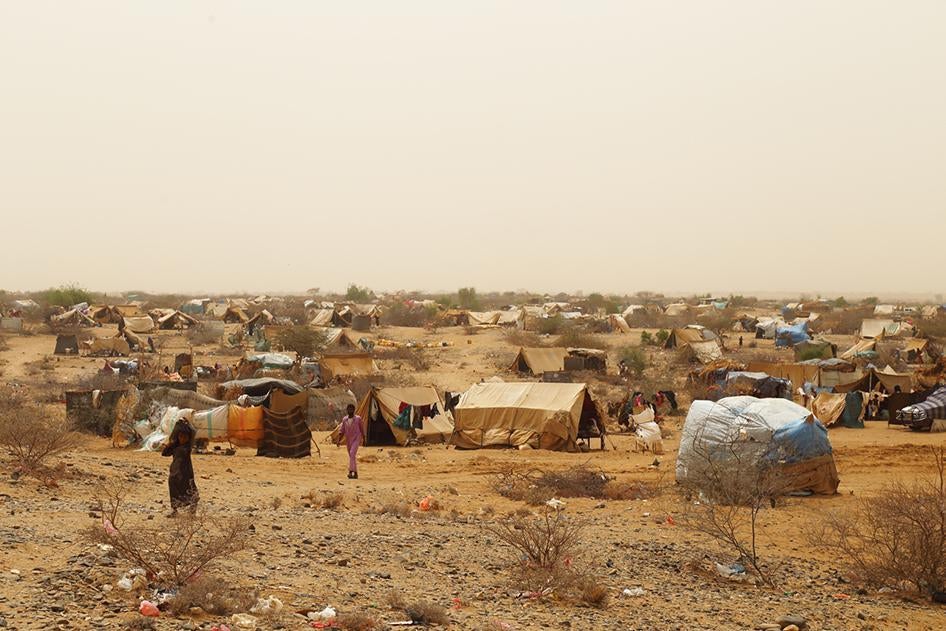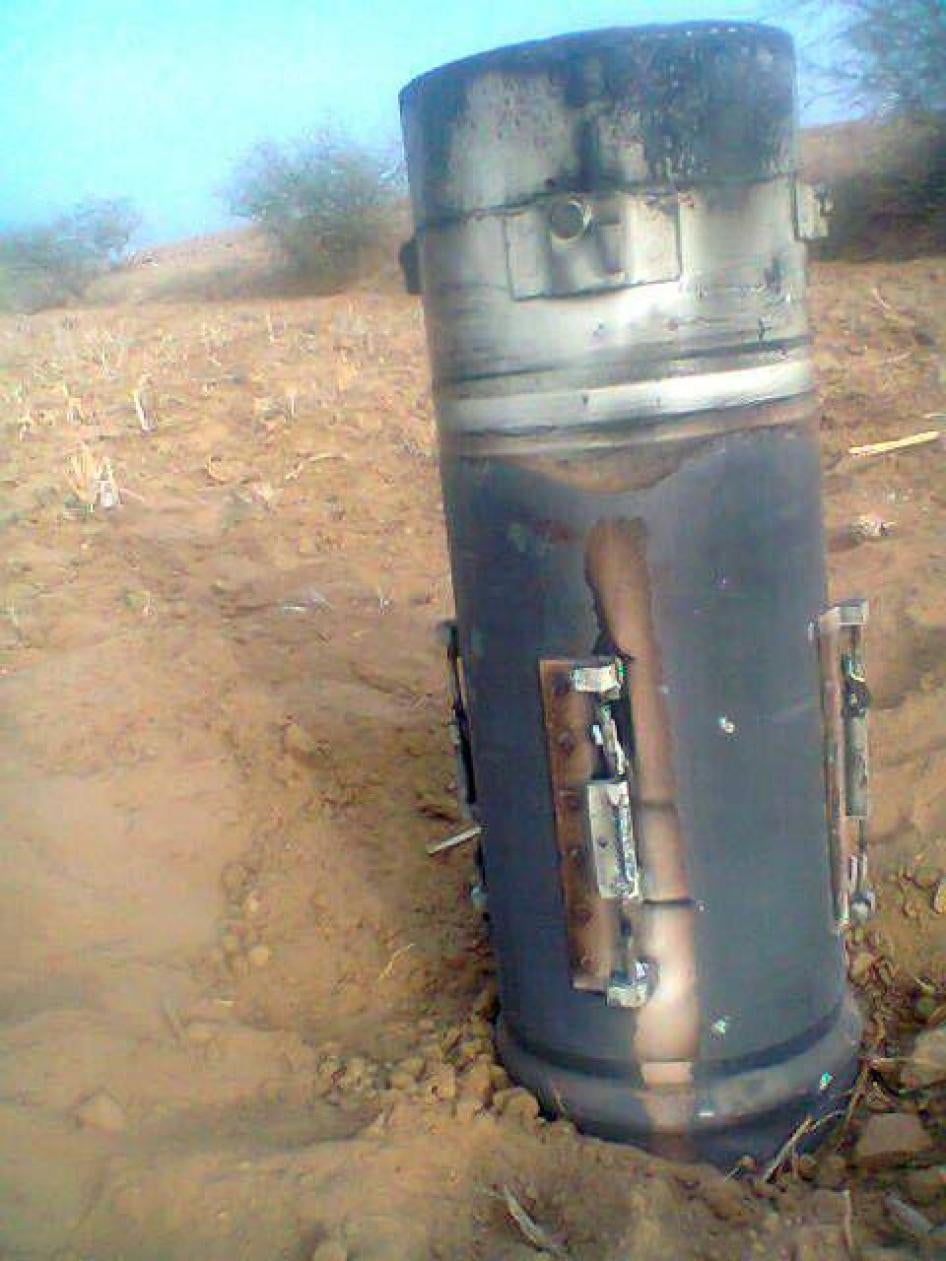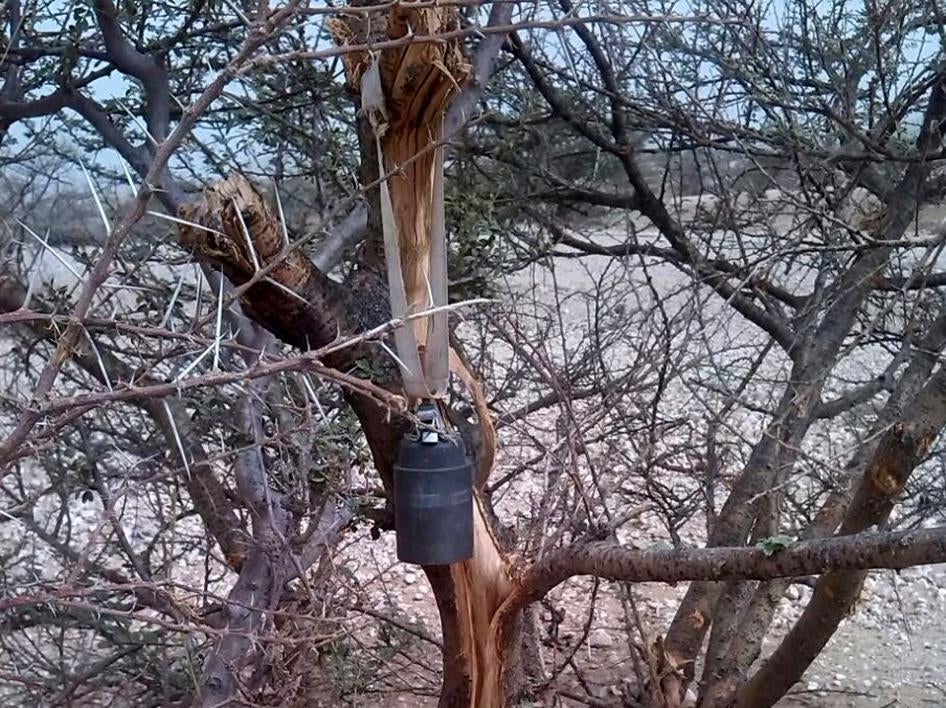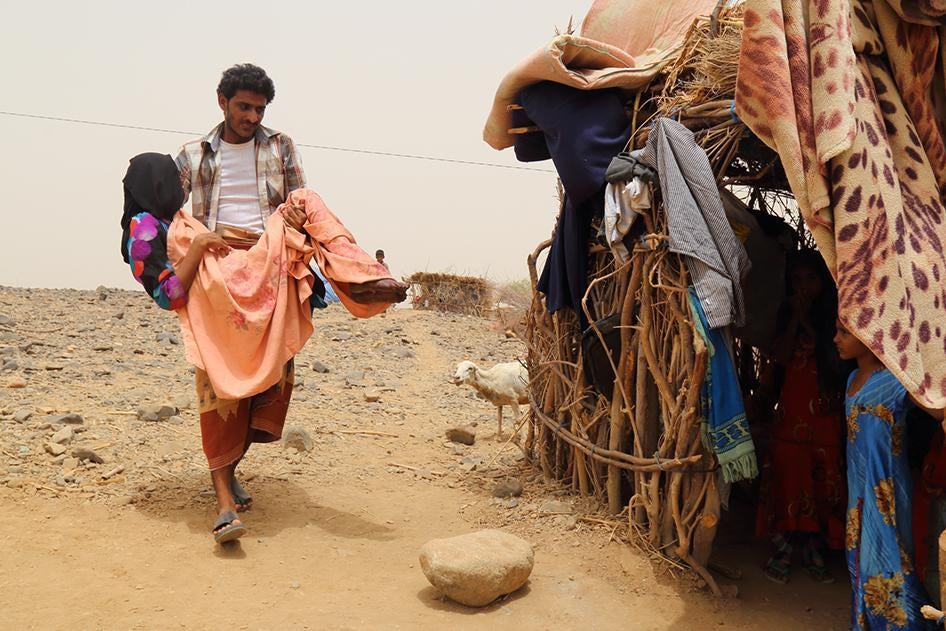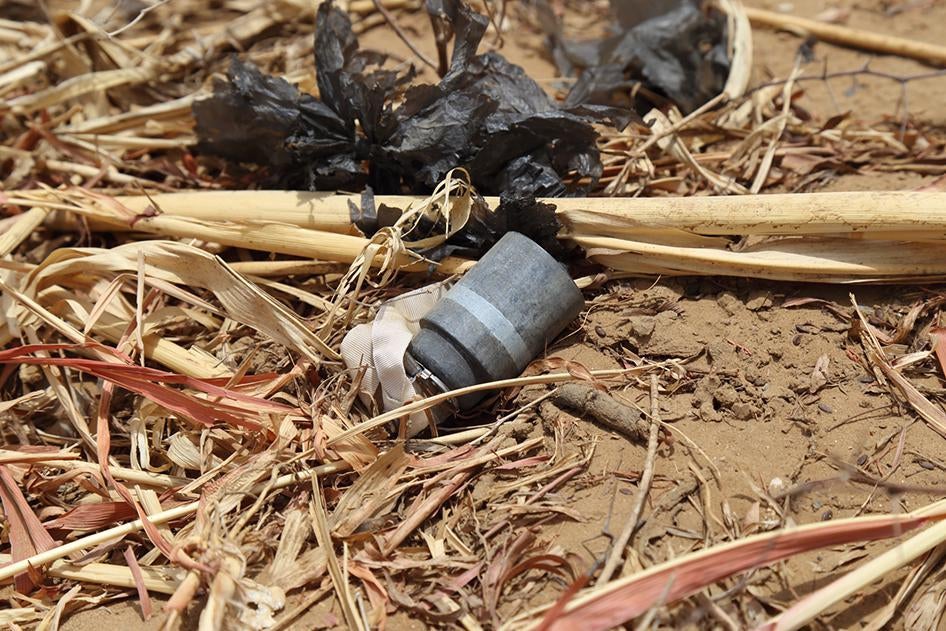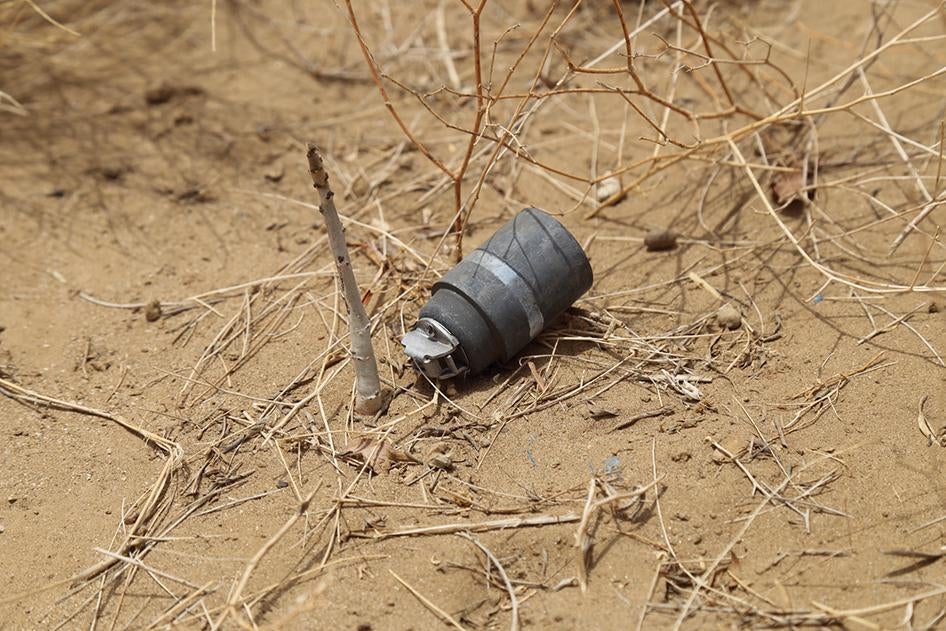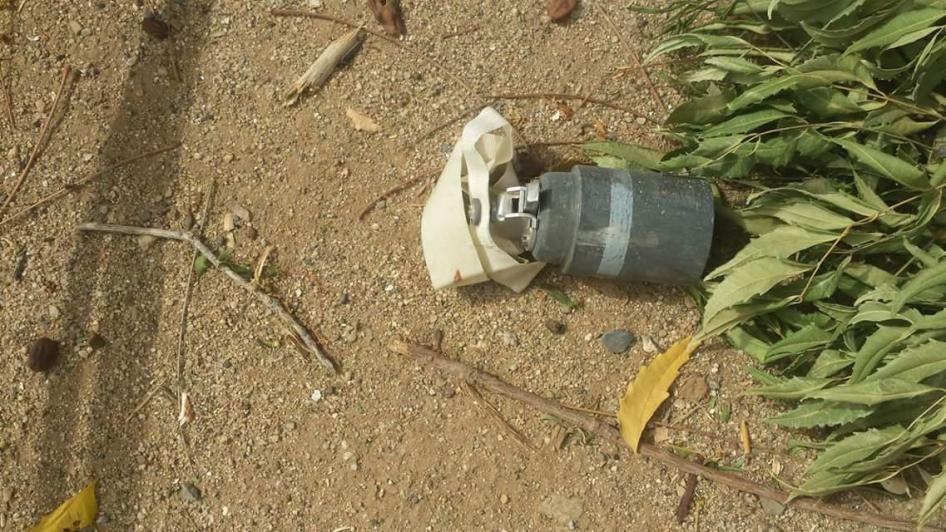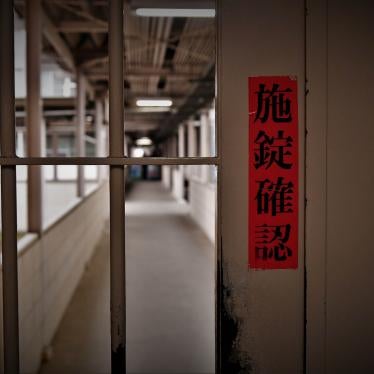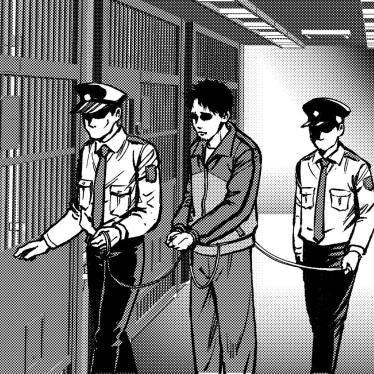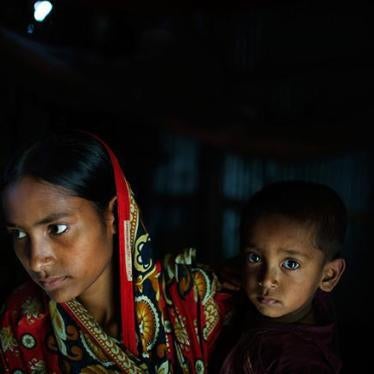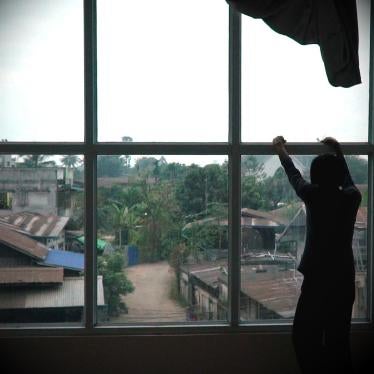Just before midnight on June 7, cluster munitions were used in an attack on the village of Malus in the al-Fag directorate of Haradh District, local residents told Human Rights Watch. Malus is 30 kilometers east of the town of Haradh and 5 kilometers south of Yemen’s border with Saudi Arabia.
Human Rights Watch interviewed 11 people from Malus, including five who were injured in the attack, in a camp for displaced people in Hayran District. The Malus residents provided the names of seven local people, including three children, who were killed in the attack, and another 17 who were wounded.
Muhammad al-Marzuqi, 30, who sells qat (a leaf widely consumed in Yemen as a stimulant) in Malus, said that he looked out the window after hearing explosions in the village:
I saw a bomb exploding in the air and pouring out many smaller bombs. Then an explosion threw me on the floor. I lost consciousness and somebody transferred me to the hospital with burns and wounds on the heels of the feet and fragmentation wounds on the left side of my body.
The attack also wounded two of his children. Ismail, 13, showed Human Rights Watch a scar on his inner, upper left thigh that had resulted from surgery to remove fragments. Saria, 9, showed a scar on her right knee, which was still stiff from the injury.
Muhammad Rabi said his 13-year-old son was fatally wounded in the attack: “I took him to the hospital, but he died as soon as we arrived. I stayed with him till the morning, then buried him in Hayran. I didn’t even take him back home. Residents of the village all fled. You can’t find anyone there now.”
Human Rights Watch also interviewed Fatima Ibrahim al-Marzuqi, whose legs were injured in the attack. Despite several operations, she still could not walk. Her brother Yahya Ibrahim al-Marzuqi, 22, who was also wounded in the attack, has been carrying her.
Muhammad Swaid al-Marzuqi, about 70, said:
I was sleeping a few meters from my son’s grocery shop when I heard the explosions. I got up and saw the shop was burning, and then I saw burning fires and smoke in many locations in the village and understood that the whole village had been attacked.
The villagers said that at least two submunitions failed to explode; one was found on a road and another hanging from a tree branch. One villager provided photographs that he said he had taken in and near the village. The photographs show an unexploded M77 DPICM submunition hanging from a tree and the remnants of several M26 rockets. At an ad hoc camp for displaced people in Beni Hassan, a Malus resident showed Human Rights Watch a piece of a white ribbon from an M77 DPICM submunition that he had found in the village after the attack.
Dughayj Village, Hayran District
Cluster munition rockets were used in an attack on the village of Dughayj in the Hayran district, 20 kilometers from Yemen’s border with Saudi Arabia, in late June or early July, local residents told Human Rights Watch.
Adel Hassan, 15, a Dughayj resident, told Human Rights Watch researchers who visited the village on July 27 that the attack took place at about 1 p.m. “less than a month” earlier. He said the attack killed about 10 people, all civilians, and wounded 30 others. He named five of the dead, including three women, but said he could not identify other victims, most of whom had come to Dughayj after being displaced from other areas by the conflict.
Hassan said that he saw 10 unexploded submunitions after the attack and that his cousin had destroyed others. Local residents said that Houthi forces had removed unexploded submunitions from the village. Nevertheless, during a visit to the village on July 27, Human Rights Watch found an unexploded M77 DPICM submunition.
Other local residents confirmed the attack and a resident of the neighboring Haradh District said that a villager from Dughayj had brought him an unexploded submunition after the attack.
Al-Hazan Village, Haradh District
Cluster munition rockets hit agricultural land near the village of al-Hazan in the Hayran district, 20 kilometers from the Saudi-Yemeni border, in late May or early June.
One villager said that on the night of the attack he saw flashes from rockets that appeared to have come from the direction of Yemen’s border with Saudi Arabia. Shortly thereafter, he saw multiple flashes in the air above the village, followed by dozens of explosions, “like the sound when you dump a load of rocks from a truck.”
The submunitions fell in farming land belonging to three villages, which have a combined population of about 3,000.
The attack injured one man, who had been displaced from another village by the war, in his chest and back, the villagers said. Unexploded submunitions in the fields subsequently detonated after being disturbed and injured three farmers in separate incidents: a 17-year-old was injured in his abdomen, a 70-year-old man in his legs and hand, and a 31-year-old man in his leg.
A farmer showed Human Rights Watch the fields where the submunitions landed, where dozens of small craters remained visible in the soft soil. Human Rights Watch found three unexploded M77 DPICM submunitions, as well as pieces of the white stabilization ribbons from submunitions that had exploded. One submunition was almost completely buried in the sand with only part of the ribbon visible. Another was on a path between two fields with a rope tied to the white ribbon, apparently by someone trying detonate it by yanking on the ribbon.
The presence of unexploded submunitions in the fields is having a negative effect on farmers’ livelihoods, locals said. “We can’t work the fields anymore because of the submunitions,” said Ali Muhammad Gahshor, 52.
Some villagers said that Houthi forces were using a nearby house at the time of the attack and might have been its target.
Bani Kaladah Village, Haradh District
Cluster munition rockets were used in attacks near the village of Bani Kaladah in Haradh District, 5 kilometers west of Haradh and 7 kilometers from the Saudi-Yemeni border, in late April or early May.
One villager said that his brother found 12 unexploded submunitions near their family home when he returned to the village on May 13. The submunitions had landed in the fields, affecting at least 10 farms, the villager said.
The villager sent Human Rights Watch photographs that he said a friend had taken in fields near his house. The photographs showed remnants of at least one M26 rocket and one unexploded M77 DPICM submunition.
On July 27, Human Rights Watch went to see the villager’s house where the 12 submunitions were said to have been found but the house had been reduced to rubble, apparently from one or more bombs, making it unsafe to search for unexploded submunitions. Human Rights Watch found the remnants of an M26 rocket about a kilometer north of the house. One local resident said that Houthi forces had cleared the area of unexploded submunitions after the attack.
A resident said that Houthi forces were using local roads, abandoned houses, and farmland to launch attacks against Saudi forces, and had told residents to vacate the area on April 5. The local council had also signed an agreement with the Houthis declaring the area a military zone, he said, although some civilians remained in the village.
Haradh Town, Haradh District
Cluster munition rockets were used in an attack on the outskirts of Haradh, a town 11 kilometers from the Saudi-Yemeni border, on July 25, Houthi fighters and a local medical worker told Human Rights Watch. Human Rights Watch found cluster munition remnants at the site two days after the attack.
A medical worker at Haradh’s hospital said that cluster munitions were used in an attack on the western part of town on July 25 and showed Human Rights Watch photographs of two unexploded M77 DPICM submunitions that she said were found in the impact area. The medical worker said the submunitions fell over a large area around the road leading to the port town of Midi.
Inspecting the site on July 27, Human Rights Watch found that some submunitions appeared to have hit close to a Houthi-run military checkpoint. A Houthi fighter patrolling the road in the area at the time of the attack told Human Rights Watch that the cluster munition attack occurred at about 5 p.m. on July 25:
I heard a massive explosion in the air and I saw a red flash followed by a series of explosions on the ground. Many submunitions fell on houses, but they were empty because most Harad residents had already left.
The Houthi fighter showed Human Rights Watch a bucket containing five unexploded M77 DPICM submunitions that he said had been collected from around the checkpoint.
Al-Fajj Village, Haradh District
A local resident said that cluster munition rockets hit his father’s farm in al-Fajj village about a month before Human Rights Watch spoke to him in an area for displaced people in Hayran district on July 25. Al-Fajj is 5 kilometers northeast of Haradh and 10 kilometers south of Yemen’s border with Saudi Arabia.
The cluster munition rocket attack killed at least one woman and wounded her husband, he said.
The resident said that he saw unexploded submunitions at his father’s farm as well as at other farms and in the mountains nearby. He said that the submunitions had white ribbons attached to them and that their bottom was hollow with a reddish color, a description consistent with M77 DPICM submunitions. He said that he destroyed one submunition by throwing it against a wall, causing it to explode.
An acquaintance shared two photographs that he said were taken in al-Fajj that Human Rights Watch identified as unexploded M77 DPICM submunitions.
